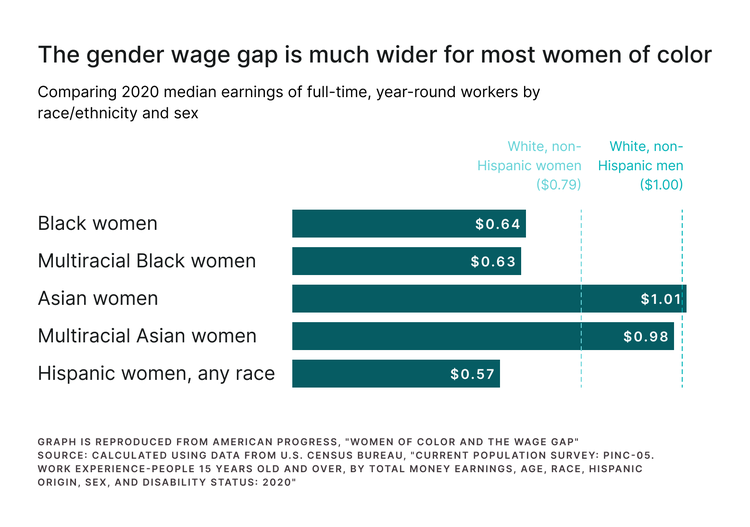
International Equal Pay Day: What it is and why it matters

Written by

Senior Content Marketing Manager, Culture Amp
Note: This article focuses primarily on the unadjusted pay gap (which measures the average difference in salary between women and men) versus the adjusted pay gap (which takes into account other factors that affect pay, such as job role, education, and experience). While the nuances of the adjusted pay gap are worth exploring, we have chosen to examine the unadjusted pay gap for the reasons explored in these two articles. We further note that due to data limitations, we refer to the wage gap that exists for binary genders. (1)(2)
It’s 2023, and you would think that by now, equal pay for equal work would be a given. Yet, women worldwide still earn less than men for doing the same job, even with the same experience and education level – and even within the same company. Globally, the United Nations reports that women, on average, make 77 cents for every dollar earned by men. At the current rate, it is expected to take 257 years to close the global gender pay gap.
While the gender pay gap has narrowed over the years, progress is slow, and the negative economic consequences experienced by women continue to accumulate. For example, women in the United States have lost over $61 trillion in wages since 1967, the first year for which U.S. Census Bureau data is available. As a result, women have less money to support and care for themselves and their families. These lost wages translate directly to lower lifetime earnings for women, which affects their ability to save and invest for the future.
In 2023, the World Economic Forum found that the global gender pay gap is 68.4% closed, representing an improvement of 0.3% compared to 2022. Yet, these marginal improvements are diluted by an increasing number of countries that have experienced widening gender pay gaps. In the United States specifically, the Pew Research Center reports that progress toward narrowing the gender pay gap has all but stalled in the 21st century.
The existence of the gender pay gap and its negative consequences are practically indisputable when we look at the hard numbers and years of research. Yet, many still question this reality – an online poll of 8,566 American adults found that nearly half of men (46%) believe that the pay gap “is made up to serve a political purpose” rather than being a “legitimate issue.” This is despite all the data, statistics, and studies that prove it exists.
It’s for all these reasons and more that the United Nations created International Equal Pay Day. It’s a day that aims to start a dialogue and spur action among both the skeptics – who may need more information – and the believers – who may need inspiration for turning their values into tangible progress.
In this article, we will discuss what International Equal Pay Day is and share tips for taking effective action to close the gender pay gap.
What is International Equal Pay Day?
The UN established International Equal Pay Day in 2019 to draw attention to the gender pay gap and the systemic inequalities at its root. Commemorated annually on September 18, the day aims to bring awareness and legitimacy to the issue of gender-based pay discrimination worldwide.
What causes the gender pay gap?
Various complex, systemic factors contribute to the gender pay gap. Gendered perceptions and expectations follow boys and girls from birth, affecting the trajectory of their lives as they progress from education and training to the workforce. Once they start working, women and men again face a myriad of gendered biases that affect them throughout their careers. Consequently, women and men participate in the workforce differently and are treated differently by leaders and employers.
Examples of factors that contribute to the gender wage gap include:
- Discriminatory practices and bias against women across the employee experience (e.g., hiring, performance reviews, promotion opportunities, etc.)
- Different expectations for family caregiving responsibilities between women and men
- Occupational segregation, which occurs when men are encouraged to enter traditionally male-dominated jobs (which are generally higher paid) and women are encouraged to take on traditionally female-dominated jobs (which are generally lower paid, despite requiring the same level of skill). This is exacerbated by the fact that when women do enter a traditionally male field, average wages for the occupation on the whole decrease.
- Differences in how men and women negotiate salary and employers’ responses to those negotiations
How to take effective action on International Equal Pay Day
Gender-based pay discrimination is a complex issue that’s not easy to solve, but few meaningful causes are. Below, we share a few tips and ideas for individuals and organizations who are ready to commit to the hard work of eliminating the gender pay gap and, ultimately, creating an equitable and inclusive world of work.
Address diversity in leadership
Closing the gender wage gap requires more than hiring women into entry-level roles – companies must prioritize and maintain gender diversity in leadership. After all, if women continue to be excluded from the highest-paid executive positions, it is numerically impossible to achieve gender wage parity.
Here are five ideas to improve diversity in leadership:
- Set a quantifiable goal
- Be mindful of unconscious biases in job descriptions and the hiring process
- Work with external recruiters that focus on creating opportunities for leaders from marginalized backgrounds
- Tap into diverse talent networks
- Provide internal advancement opportunities to all employees
Conduct equity analyses across the employee experience
To ensure that your company is not unknowingly perpetuating the gender wage gap, conduct equity analyses of the following policies:
- Hiring
- Promotion
- Salary
These analyses are an objective, statistical way for you to discover if any disparities exist at your company. For example, they can help you determine whether promotions and performance evaluations are based strictly on merit, and whether your company truly provides equal pay for equal work.
Keep intersectionality at the forefront
The gender pay gap is largest for those who exist at the intersection of multiple marginalized identities (i.e., a black woman with disabilities). Like any group, women are not a monolith. As illustrated below, the gender wage gap is much wider for most women of color.

For this reason, it is essential to look at the gender pay gap through the lens of intersectionality. That way, you can ensure that your efforts benefit the most marginalized members of your workforce instead of unintentionally widening the gap between better-off communities and the communities that most need attention.
Educate yourself and others on the gender pay gap
Promote equal pay in your corporate culture and encourage employee dialogue around the topic.
Because there are many ways to calculate the gender pay gap, people in your workplace likely hold strong, contrasting opinions on whether the gender pay gap is “real” or not. Skeptics may exist at every level of the organization, so it’s pivotal to make this topic a key point of discussion among not just individual contributors but managers and C-suite executives. Only in doing so can you mitigate the effect of unconscious biases as you drive organization-wide change.
Resources:
- What is the gender pay gap and is it real? (Economic Policy Institute)
- The Simple Truth About the Gender Pay Gap (American Association of American Women)
- Gender Pay Gap (Pew Research Center)
- What is meant by the Gender Pay Gap? (Deloitte)
- Equal Pay Resources (Lean In)
Create a more equitable and inclusive workplace, every day
International Equal Pay Day is an opportunity to raise awareness about the gender pay gap and take meaningful action against it. We all have a role to play in achieving this goal. Through targeted action and thoughtful leadership, we can work together to end the gender pay gap and ensure that all employees, regardless of gender and identity, receive equal pay for equal work.






